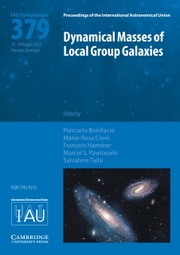No CrossRef data available.
Article contents
Close-up view of an ongoing merger between the NGC 4839 group and the Coma cluster
Published online by Cambridge University Press: 07 April 2020
Abstract
Core share and HTML view are not available for this content. However, as you have access to this content, a full PDF is available via the ‘Save PDF’ action button.
We analyse archival XMM-Newton observations of the massive galaxy group NGC 4839 falling into the Coma cluster core, which reveal a complex morphology for the merger. By comparing high quality X-ray maps of the merging subcluster with SPH simulations, we propose an infall scenario which qualitatively reproduces the observed structure of the NGC 4839 tail.
Keywords
Information
- Type
- Contributed Papers
- Information
- Proceedings of the International Astronomical Union , Volume 14 , Symposium S342: Perseus in Sicily: From Black Hole to Cluster Outskirts , May 2018 , pp. 133 - 136
- Copyright
- © International Astronomical Union 2020
References
Akamatsu, H., Inoue, S., Sato, T., Matsusita, K., Ishisaki, Y., & Sarazin, C. L., 2013, PASJ, 65, 89CrossRefGoogle Scholar
Biviano, A., Durret, F., Gerbal, D., Le Fevre, O., Lobo, C., Mazure, A., & Slezak, E., 1996, A&A, 311, 95Google Scholar
Neumann, D. M., et al., 2001, A&A, 365, L74 Neumann D. M., Lumb D. H., Pratt G. W., & Briel U. G., 2003, A&A, 400, 811Google Scholar
Smith, R. K., Brickhouse, N. S., Liedahl, D. A., & Raymond, J. C., 2001, ApJ, 556, L91CrossRefGoogle Scholar
Zhang, C., Yu, Q., & Lu, Y., 2014, ApJ, 796, 138 Zhang C., Yu Q., & Lu Y., 2015, ApJ, 813, 129CrossRefGoogle Scholar

